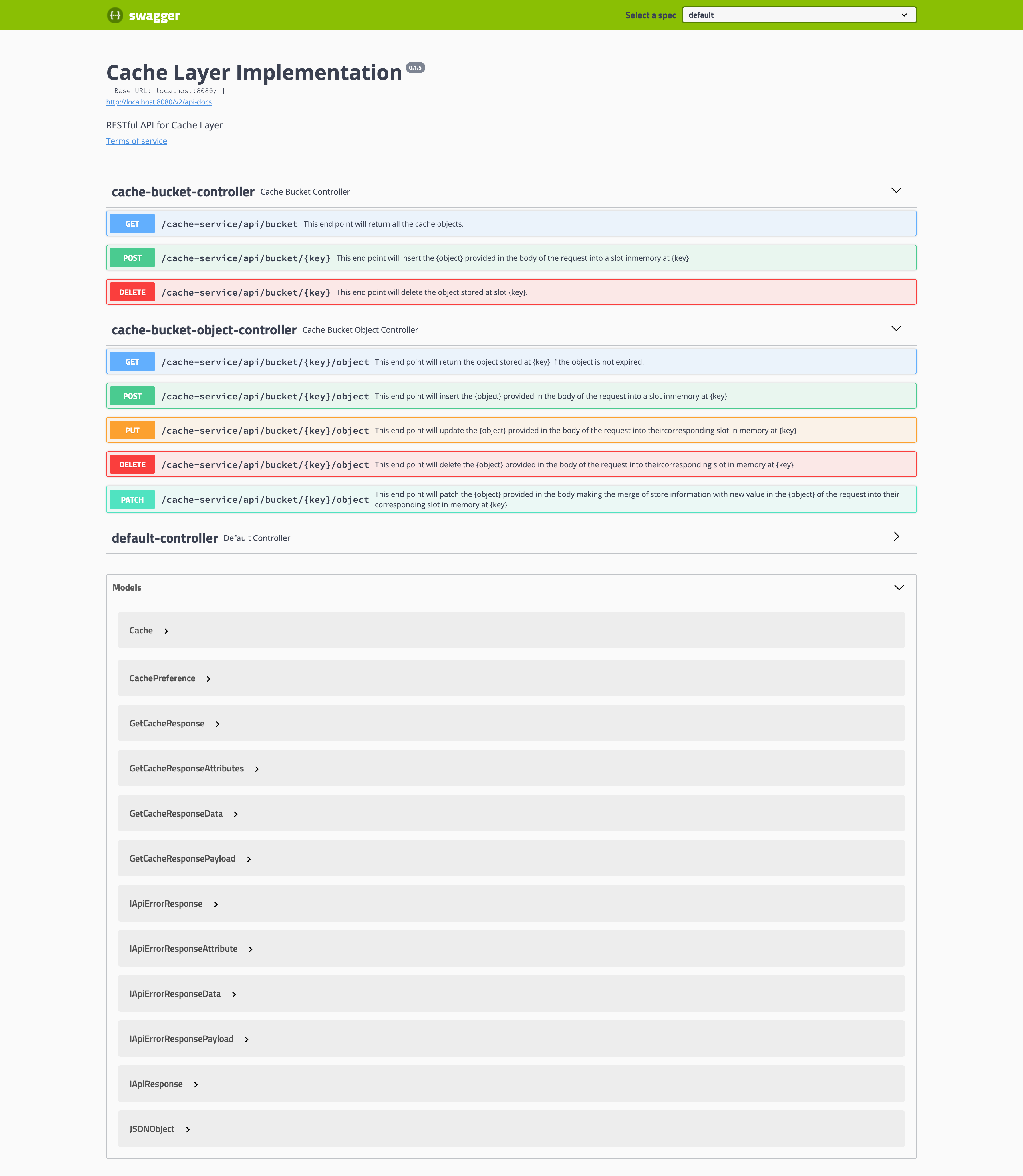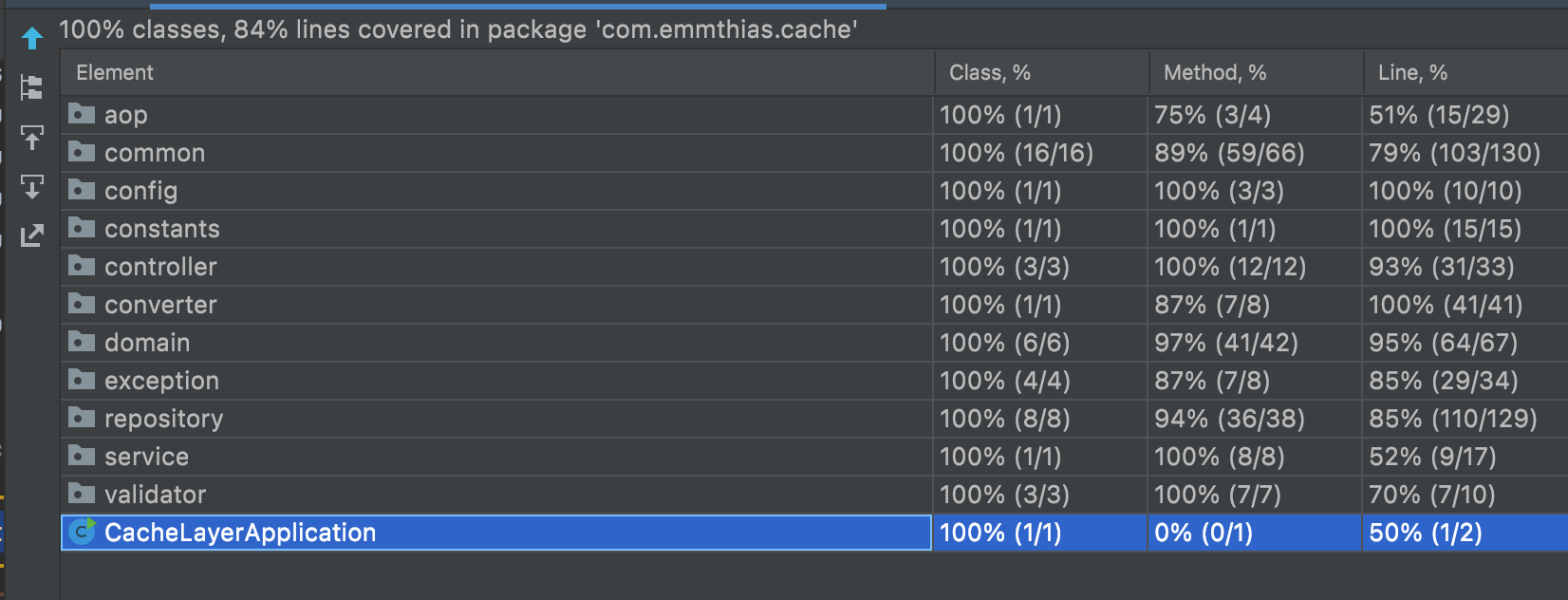This project is my own implementation of a cache layer, based on the details described in the following Backend_Take_Home_Assessment
Click to Expand details
Your task is to create an in-memory cache with a REST interface. This cache will store JSON objects (strings) in the server’s memory that can be accessed via the API. For simplicity the server is single-threaded. The cache accepts the following configuration parameters:
-
Number of slots (int, default 10,000):
Maximum number of objects to be stored simultaneously in the server’s memory. If the server runs out of slots it will behave according to the **Eviction Policy setting** -
Time-To-Live (int, default: 3600 secs):
Object’s default time-to-live value in seconds if no TTL is specified as part of a write request. If TTL is set to 0 that means store indefinitely (until an explicit DELETE request) -
Eviction Policy (enum, default: REJECT):
This indicates what to do when the cache runs out of slots. The following options are: ○ OLDEST_FIRST: If there are no slots available the cache will evict the oldest active object and store the new object in its place ○ NEWEST_FIRST: If there are no slots available the cache will evict the newest active object first and store the new object in its place ○ REJECT: When the cache runs out of storage it just reject the store request
The REST API will support the following operations:
● GET /object/{key}
○ This will return the object stored at {key} if the object is not expired.
○ Returns
■ 200: If the object is found and not-expired
■ 404: If the object is not found or expired
● POST or PUT /object/{key}?ttl={ttl}
○ This will insert the {object} provided in the body of the request into a slot in memory at {key}. If {ttl} is not specified it will use server’s default TTL from the config, if ttl=0 it means store indefinitely
○ Returns
■ 200: If the server was able to store the object
■ 507: If the server has no storage
● DELETE /object/{key}
○ This will delete the object stored at slot {key}
○ Returns
■ 200: If the object at {key} was found and removed
■ 404: If the object at {key} was not found or expired
- Maven
- Docker
- Java 11
- Spring boot 2.5
- log4j2
- spring-boot-starter-aop
if you want to try the docker version located in dockerHub run the following command
docker pull polanco/cache-layer:latest* The docker image is available at port 80 http://localhost/swagger-ui.html
* additional there is a postman collection that you can use, see more details on test section
or if you eant to create your own local docker version run the following command.
docker build . -t cache-layer && docker-compose upThe In-Memory cache structure is based on Map data structure:
Map<String, ICacheRepository>The key is String passed as a Path Variable in the URL.
The value ICacheRepository is the interface that handle the Eviction cache policy.
The ICacheRepository has its custom implementation one per each eviction policy
- NewestFirstCacheRepository -> implements
LinkedHashMap- Taking the
keySet - Convert into a list
- Subtract the elements to be replaced from the
List - Remove the values from the bottom to top
- Insert the new elements into the LinkedHashMap.
- Taking the
- OldestFirstCacheRepository -> Implements a
LinkedHashMap- Override the
removeEldestEntrymethod
- Override the
- RejectCacheRepository -> Implements a
HashMap- Add a singleton (enum) validator
- Avoid the insertion
The structure in ICacheRepository is the following.
Map<String, JSONObject>The key is a calculated value based on the possible properties into the provided json.
- iterates over an array value from the yml file
cache:
suggested-key-properties-ids-for-cache-object: id, ID, Id, iD, name- if any property is present it will take it as a key, otherwise will take the
hashCodevalue
The value is the json object provided.
The project has 3 endpoints:
| Name | endpoint | usage |
|---|---|---|
| default | / |
[project version , _health_check] |
| bucket | cache-service/api/bucket |
Handle the parent container (where the objects live) |
| objects | cache-service/api/bucket/{key}/object |
Handle the object operations |
-
POST/cache-service/api/bucket/{key}This endpoint creates a bucket with specified key{ "cachePreference": { "slotNumber": 5, "timeToLive": 0, "evictionCachePolicy": "REJECT" }, "elements": [ { "id": 1, "name": "jp" } ... ] } -
DELETEcache-service/api/bucket/{key}This endpoint deletes a bucket with specified key -
GETcache-service/api/bucketThis endpoint retrieve all the buckets in memory with their associated objects and cache preferences
All the object endpoints expect the following structure in the body request section.
{
"element": {
"id": 1,
"flag": true,
"extra": 9
}
}-
POST/cache-service/api/bucket/{key}/objectThis endpoint adds objects into a bucket with specified key -
DELETE/cache-service/api/bucket/{key}/objectThis endpoint deletes object into a bucket with specified key -
PUT/cache-service/api/bucket/{key}/objectThis endpoint replaces object into a bucket with specified key -
PATCH/cache-service/api/bucket/{key}/objectThis endpoint Merges object into a bucket with specified key
The cache preference has the following precedence:
- The values provided in the body payload in
/cache-service/api/bucket/{key} - The values provided in application.yml
cache-service:
preference:
slotNumbers: 10
timeToLive: 3600
evictionCachePolicy: OLDER_FIRST- The default values mentioned in the pdf file.
The easiest way is importing the Postman Collection
to run from source code you will need to add variable environment
APP_ENV=local


